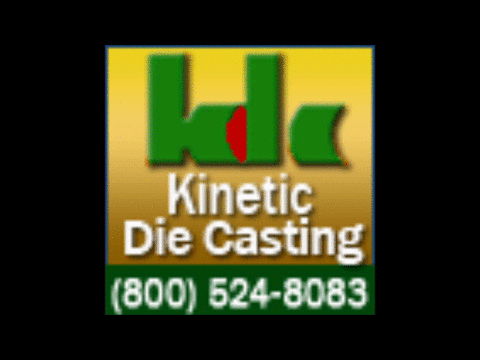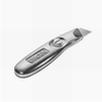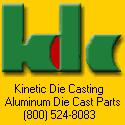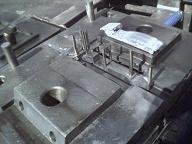Kinetic Die Casting Company discusses “Draft Angle in Die Castings” – “what is draft angle in an aluminum metal box casting?” or “why do I need a draft angle on my aluminum die casting box part?” The mechanical reply is, …
Continue reading
Category Archives: Die Casting Alloys
Aluminum Manufacturing
 Aluminum Manufacturing. Aluminum is widely used in die casting because of the properties that it possesses. Aluminum is useful even in everyday life because that is why die casting companies produce die cast parts made from this alloy. Aluminum alloy is lightweight and has good corrosion resistance. It can also take high temperatures so the things that need to be heat resistant are usually made of aluminum alloy. The things that also need high corrosion resistance and electrical conductivity are made of aluminum. Due to its high dimensional stability, aluminum alloy is used to make thin walls and complex shapes.
Aluminum Manufacturing. Aluminum is widely used in die casting because of the properties that it possesses. Aluminum is useful even in everyday life because that is why die casting companies produce die cast parts made from this alloy. Aluminum alloy is lightweight and has good corrosion resistance. It can also take high temperatures so the things that need to be heat resistant are usually made of aluminum alloy. The things that also need high corrosion resistance and electrical conductivity are made of aluminum. Due to its high dimensional stability, aluminum alloy is used to make thin walls and complex shapes.
Furthermore, Aluminum die casting part types can depend on the combination of alloying elements such as silicon and copper. Zinc can also be used as alloying element to aluminum. The combination of the properties of the different alloys allows the production of high quality products. Silicon increases melt fluidity that is why complex parts such as connector housings and thin walls are made of aluminum with silicon. When copper is used as the alloying element, the part has increased hardness and decreased ductility.
Aluminum part types can be differentiated on the amount of alloying element present. Aluminum types are Alloy A380, A360, A369, A390, A413, and A518. They are series of aluminum alloys so expect to see alloy types with decimals. The Alloy A380 is the most common aluminum alloy used in die casting. Lawnmower housings and gears are usually made of AA 380. Escalator parts and conveyor parts are usually made of Alloy 518. Parts that need high corrosion resistance are made of Alloy A360 aluminum parts.
Parts differ in the content of alloying element that makes the aluminum part types. They also cater to the different needs of the consumers and the producers as well. These are the most common Aluminum Alloy Types.
Kinetic Die Casting Company makes Aluminum Casting Parts. As a die casting company, we make these parts every day and ship thousands of these aluminum die castings every week.
Contact us to get die casting prices http://www.kineticdiecasting.com/replyform.html.
Kinetic Die Casting Company
6918 Beck Avenue
North Hollywood, California 91605
Sales@kineticdc.com
Made In California Featured Manufacturer
Thank you CMTC for recognizing #kineticdc as a leader in die castings in California.

Kinetic Die Casting Company is the featured manufacturing company in the CMTC Made In California website (http://www.cmtc.com/made-in-california-profile/kinetic-die-casting-company-inc).
Our Capabilities:
Die castings produced from 50 to 100 aluminum parts each day (low customer demand).
Die castings produced to over 5,000 aluminum parts a day (high customer demand).
Aluminum die casting part sizes from .001 pounds to 10 pounds.
Die casting aluminum part sizes range from .025″ x .025″ to 15″ x 15″.
Aluminum: 380, 383, 360, and 413 Die Casting Alloy.
Kinetic Die Casting Company
6918 Beck Avenue
North Hollywood,
California USA 91605
818-982-9200
800-524-8083
sales@kineticdc.com
Made in CA featured: http://www.cmtc.com/made-in-california-featured-manufacturers
California Manufacturing Technology Consulting® (CMTC)
Zinc and Aluminum Alloys
Zinc Die Casting ZINC-ALUMINUM (ZA) ALLOYS. There are several different types of alloys available. Die casting alloys can have physical and mechanical properties for pretty much any application a designer or consumer may require.
Zinc die-casting alloys are stronger, harder, and more flexible than other alloys such as aluminum or magnesium. Zinc alloys could be used to cast amazingly miniature, multifaceted shapes. They might be manufactured smoother, modest, more exact, and at lower cost. Zinc die castings can additionally be painted and can be better plated than aluminum or magnesium alloys. Zinc’s low temperature point allows for a longer die life, even when making large quantities of parts. Zinc die-casting is less costly allowing segment fashioners and clients to create tight dimensional tolerances, quick creation process durations, slender divider segments, and high mechanical properties.
To a great degree miniature castings are transported on distinctive hot-chamber machines with high pressure durations. These machines produce close-tolerance castings that also does auxiliary trimming or machining operations. The four-slide machine uses sliding to deliver intensely perplexing and tight-tolerance segments with openings perpendicular to one another, under-cuts, opposite edges, and strings.
Limits on the measure of castings – more appropriate for little castings up to something like seventy-five pounds. Rigging and fail hard costs are high.
This is the blog on the Kinetic Die Casting Company web site and talks about the various Aluminum Parts Manufacturing. Look at this website page for more details: http://kineticdiecasting.blogspot.com/. Contact Kinetic Die Casting Company at 818-982-9200 or email us at sales@kineticdc.com. Use this webpage to request “die casting part prices” www.kineticdiecasting.com/replyform.html





